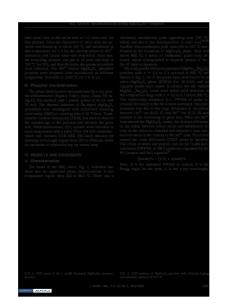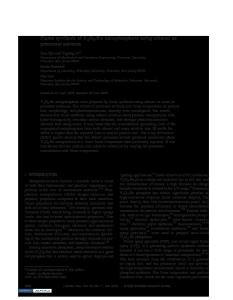Electronic Trap Defects in Y 2 O 3 :Eu and (Y,Gd) 2 O 3 :Eu X-Ray Scintillators
- PDF / 486,168 Bytes
- 7 Pages / 414.72 x 648 pts Page_size
- 94 Downloads / 381 Views
INTRODUCTION Europium doped yttria (Y203:Eu) is an important red emitting phosphor for lampsland host for high efficiency scintillators used in detectors for x-ray computed tomography. 2 The trapping of charge carriers created under high energy excitation by lattice defects can depreciate the lumen output of lamps, and for scintillators can result in detrimental long term light emission after cessation of x-ray excitation. 2 ,3 This afterglow results from thermally stimulated release of these trapped carriers with subsequent re-trapping and emission at activator sites. Afterglow emission is distinguished from directly excited radiative emission of the activator by its long
delay time and its characteristic strong dependence on temperature. Figure 1 shows the afterglow emission intensity as a percentage of steady-state intensity of two scintillators (detected with a Si photo diode) after 0.5 sec x-ray excitation. The addition of Gd alters the intensity and decay rate of afterglow, implying an influence on the physical characteristics of the defects responsible for afterglow. Using transient thermoluminescence 4 (TTL), or temperature dependence of afterglow, we have determined the fundamental physical parameters (trap energy, attempt-to-escape frequency, filling rate, and trap energy width) for the electronic defects responsible for afterglow in transparent sintered ceramics of Y203:Eu and (Y,Gd)203:Eu. Both materials have the cubic rare-earth sequisoxide C-type structure 5 with the Eu activator substituting on the Y and Gd sites. These hosts have two activator sites of C2 and S6 symmetry that can be distinguished in the luminescence emission spectrum of the Eu ion. 6 We have used this fact along with spectra of the afterglow emission to draw conclusions about energy migration and trapping within the host following cessation of x-ray excitation.
EXPERIMENTAL Figure 2a is a schematic diagram of the experimental set-up used to record TTL curves and the wavelength dispersed afterglow emission spectra. X-rays were produced by a GE 503 Mat. Res. Soc. Symp. Proc. Vol. 348. 01994 Materials Research Society
a)
Y
1.34
Gd
.W.
Eu 0 .06
F~b.
Eu 0
shun
3
0.1
TTL I
0
I
0.2 Time
0.4 (sec)
b)
I
0.6
0.8
AFG(X)
On
Off
OW
IddayTIME--
Figure 1. Room temperature afterglow of Figure 2. a) Schematic diagram of the experimental setY1 .9 4Eu.0 603 and Y1 .3 4Gd.jEu. 3 as a fraction of up used to measure temperature dependence of ve0 s atime oafterglow, TTL (left), and the emission spectrum of
steady state x-ray excited emission intensity versus time afterglow (right). b) Timing diagram of afterglow past cessation of x-ray excitation. emission experiments.
Maxiray 115T rotating anode tube placed 30 cm from the sample and excited at 50 kVp and 50 ma. This x-ray beam was modified by 4 mm of Al and 6 mm of quartz cryostat window. TTL curves were generated by exciting the sample for 0.5 sec every 10 K and recording the RCA 4832 photomultiplier tube (PMT) output at 50, 100, 200, 500 and 1000 msec past x-ray extinctio
Data Loading...











